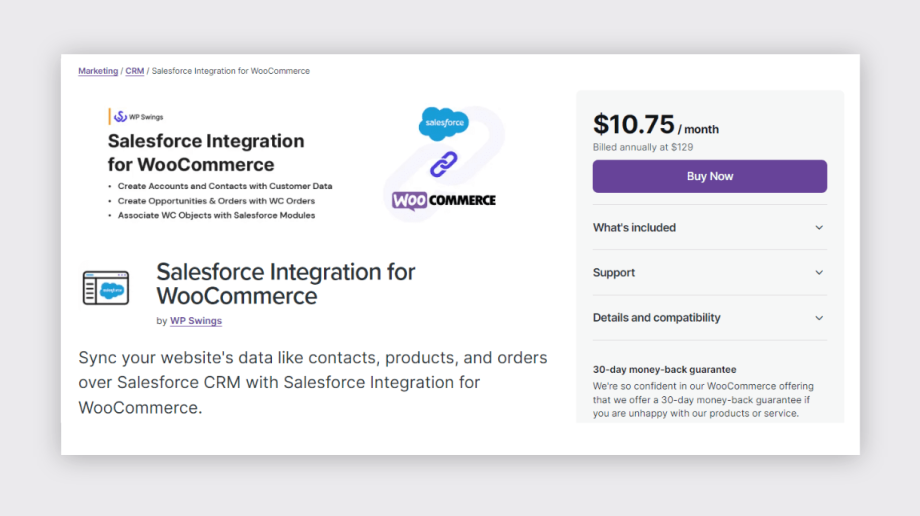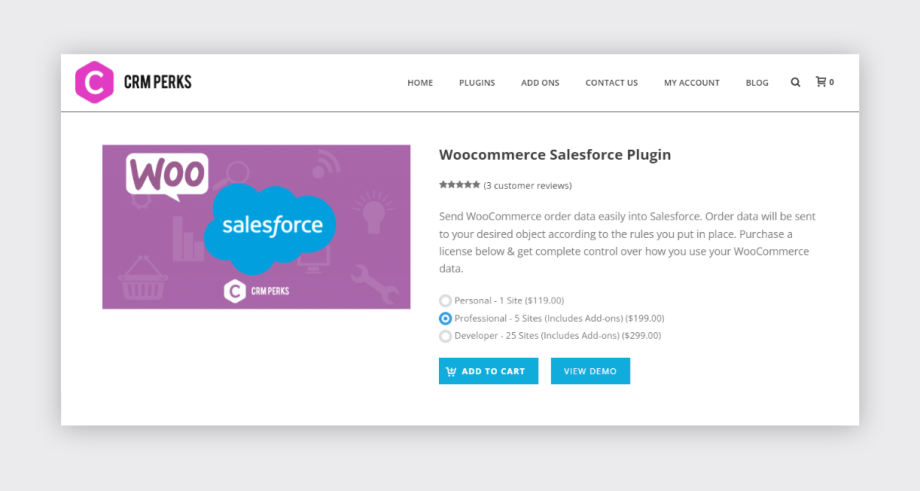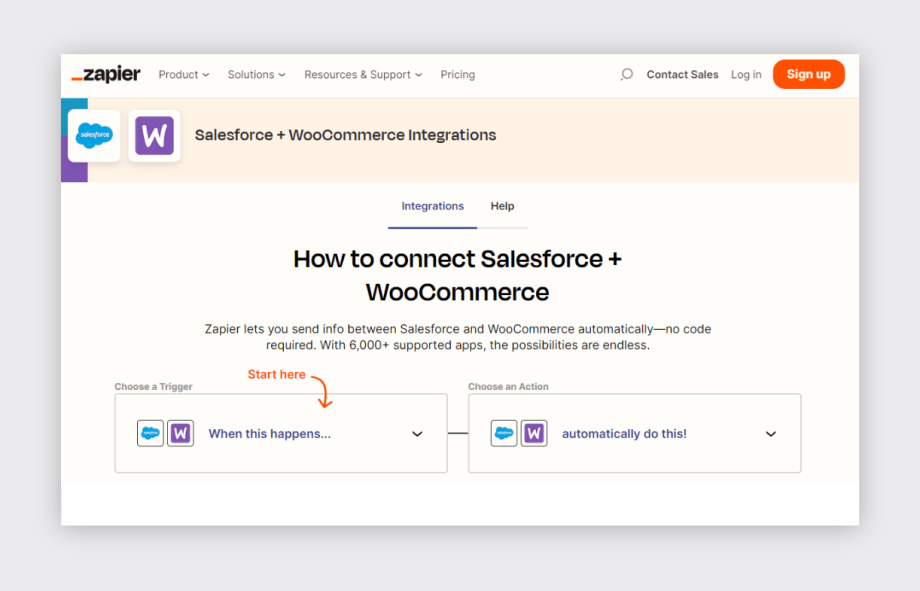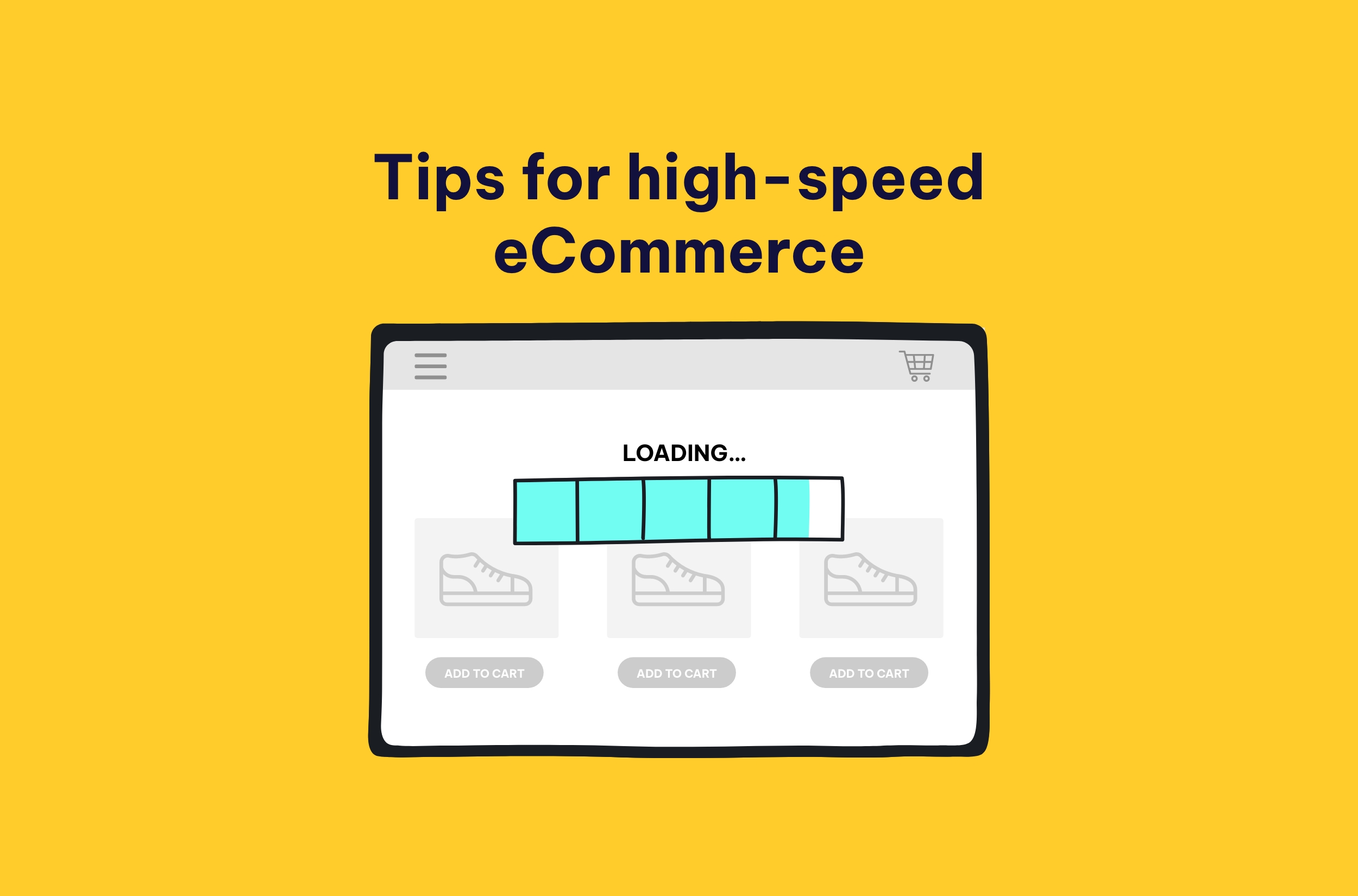Are you ready to unlock the full potential of your online business?
Imagine a world where your eCommerce platform and Customer Relationship Management (CRM) system work together in perfect harmony. Think about the time that’ll be saved, the insights that’ll be gained, and the sales that’ll be boosted!
This isn’t wishful thinking – it’s entirely possible by integrating Salesforce with WooCommerce, and we’re here to show you how in this post.
We’ll guide you through all the options and the essential steps to integrate Salesforce with your WooCommerce store to harness their combined strength.
Let’s get started!
What are the benefits of integrating WooCommerce with Salesforce?
Integrating WooCommerce with Salesforce is like unlocking a treasure trove of possibilities for your eCommerce business – here’s why:
- Customer data sync: This gives you a centralized database where every piece of customer information is just a click away. You can access your customers’ purchase history, contact info, and preferences all in one place, allowing for a more personalized shopping experience and laser-focused marketing efforts.
- Order and sales data tracking: This integration facilitates an automatic flow of order and sales data from WooCommerce to Salesforce, which is crucial for monitoring sales performance, understanding revenue trends, and studying customer purchase behavior. It’s the kind of data that empowers you to make informed, data-driven decisions.
- Marketing automation: Leverage Salesforce’s cutting-edge marketing tools to craft personalized email campaigns, targeted promotions, and effective customer segmentation, all informed by your eCommerce data. It’s about delivering the right message at the right time.
- Lead and opportunity management: Track potential customers who’ve interacted with your WooCommerce store but haven’t purchased yet. These insights are invaluable for nurturing leads and boosting conversions.
- Inventory management: Streamline inventory management by keeping an eye on stock levels, reordering products efficiently, and ensuring you’re never caught off-guard by overselling.
- Customer support and service: Utilizing Salesforce Service Cloud for customer support transforms your post-purchase service. Efficiently track customer inquiries, manage support tickets, and ensure every customer feels valued and heard.
- Reporting and analytics: Salesforce’s robust reporting and analytics tools will offer deep insights into your WooCommerce performance. You’ll understand customer behaviors, sales trends, and more to be armed with the knowledge to drive your business forward.
- Real-time data sync: With real-time data synchronization, your sales and customer information is always current and accurate, ensuring you make decisions based on the latest data.
- Workflow automation: Make your life easier by creating automated workflows in Salesforce that respond to events in WooCommerce, such as sending follow-up emails, assigning tasks, or updating records.
- Cross-channel marketing: This integration creates a cohesive customer experience across all channels, which will enhance engagement and loyalty.
What are your options for integrating WooCommerce with Salesforce?
You have several paths to choose from when it comes to merging WooCommerce with Salesforce: using Salesforce integration plugins, employing Zapier or other similar workflow automation tools, or hiring an expert developer. Each of these approaches has its own unique benefits, so let’s jump right in to find the best match for your needs.
Method 1: Salesforce integration plugins
While there’s no official plugin for this combination, several unofficial options exist – let’s look at a couple:
Salesforce Integration for WooCommerce by WP Swings

This plugin acts as a bridge between your WooCommerce store and Salesforce CRM. The key features of this tool include:
- Real-time data synchronization.
- Easy mapping of WooCommerce fields to Salesforce objects.
- Support for multiple Salesforce accounts.
However, being an unofficial plugin, it may not cover all Salesforce features comprehensively, and compatibility with future updates of either platform is not guaranteed.
WooCommerce Salesforce Plugin by CRM Perks

This plugin facilitates the transfer of WooCommerce order and customer data to Salesforce. It offers a user-friendly interface for mapping WooCommerce fields to Salesforce fields, enabling you to customize the data sync as per your requirements. Additional features include:
- Filtering options for syncing specific records.
- Support for bulk data transfer.
The limitation of this plugin lies in its dependency on WooCommerce and Salesforce updates and potential incompatibilities with other plugins or customizations you may have on your WooCommerce site.
⚠️ Please note that we haven’t tested these plugins ourselves, and so our list is not an official endorsement.
Method 2: Zapier and similar workflow automation tools
Zapier is an online automation tool that connects various web applications (including WooCommerce and Salesforce) to automate repetitive tasks without coding or relying on developers to build the integration. It’s designed for non-technical users and offers a user-friendly interface.

The versatility of tools like Zapier lies in their accessibility, making them an excellent choice for businesses looking to integrate platforms without the need for in-depth technical knowledge. However, it’s important to be aware of some limitations:
- The costs associated with Zapier’s premium plans, especially for extensive automation requirements, can be a consideration for smaller businesses or those with limited budgets.
- There may be potential delays in trigger responses, which could affect real-time data syncing.
- The level of customization available; while Zapier offers a range of pre-built Zaps, there might be specific, complex workflows that cannot be fully accommodated.
In summary, while tools like Zapier provide a valuable, user-friendly solution for integrating WooCommerce with Salesforce, weighing their benefits against their limitations is crucial, especially when dealing with more complex or unique business needs.
Method 3: Working with an expert developer
Enlisting the expertise of a WordPress development professional offers numerous advantages, ensuring that the combination of Salesforce and WooCommerce is done effectively and efficiently.
Opting for a developer or development team specializing in WooCommerce, such as our team at Saucal, guarantees a high-quality, bespoke integration solution. WooExperts understand the intricacies of both WooCommerce and Salesforce, enabling them to tailor the integration to align perfectly with your operational workflows, customer relationship strategies, and overall business objectives.
The developer’s role in integration
Working with a developer involves a collaborative process where your business needs are thoroughly understood and addressed. Our team at Saucal can help automate various workflows between the two platforms. For example, automatically create a Salesforce lead or opportunity when a new customer registers on your WooCommerce site or update customer information in Salesforce when it’s changed in WooCommerce.
Even more, we can develop a custom API integration between WooCommerce and Salesforce by creating a unique set of codes and protocols that allow the two systems to communicate effectively. This custom API ensures that specific data points, workflows, and functionalities you need are integrated correctly.
As noted by Kostas Seresiotis, our senior product engineer:
Beyond the initial setup, our developers meticulously test the integration in various scenarios to ensure robustness and reliability. This testing phase is necessary for preempting and resolving potential issues, making sure that the integration works smoothly in your live business environment.
Ongoing support and adaptability
Perhaps one of the most significant advantages of working with a developer is the ongoing support and updates they provide. A dedicated developer stays on top of any changes or updates, offering timely updates and support to ensure your integration remains compatible and efficient. This is vital for maintaining the integration’s effectiveness over time, adapting to new features, and resolving any issues that may arise.
This is especially true when you partner with Saucal. We specialize in managed WooCommerce maintenance, offering a comprehensive approach to ensure your eCommerce platform operates smoothly and efficiently.
Our dedicated team monitors and updates your WooCommerce site and proactively looks for ways to optimize performance and enhance user experience. This includes regular checks for any potential security vulnerabilities, ensuring that your site remains safe from emerging threats.
We understand that WooCommerce regularly rolls out updates and new features to enhance functionality and user experience. Our team and managed maintenance services ensures that your site seamlessly integrates these updates, maintaining compatibility with the latest WooCommerce versions.
By entrusting your WooCommerce maintenance to Saucal, you invest in a service that grows and evolves with your business.
Why working with a developer is your best option
Developers know exactly what they’re doing. They’ve seen various scenarios and have learned from them, which means they bring a wealth of practical knowledge to your project. Especially our team at Saucal. We collaborate with high-caliber entities such as Amazon and Salesforce, making us more than capable of handling complex integration projects.

Third-party tools still require some technical know-how
While third-party tools and plugins offer pathways to integrate WooCommerce with Salesforce, it’s important to recognize that they aren’t always plug-and-play solutions. A certain level of technical understanding is often required, which can present challenges for those without a technical background.
Incorporating the WoCommerce APIs
Consider, for example, the necessity of activating the WooCommerce REST APIs in your Salesforce panel. This step, while crucial for integration, is not necessarily straightforward for someone without technical expertise. Third-party tools typically come with detailed documentation, which is immensely helpful, but the effectiveness of these instructions assumes a baseline level of technical proficiency.
Steep learning curve
Users must not only comprehend the functionalities of these tools but also how they interact with the specific configurations of their WooCommerce and Salesforce setups. This learning process requires time and effort, which could be a drawback for business owners focused on day-to-day operations.
Operation issues
An integration that is not set up properly can lead to operational problems such as data mismatches, synchronization errors, and workflow disruptions. These problems can have a ripple effect, impacting customer relations, sales tracking, and overall business efficiency.
Lack of customization
Third-party tools often lack the capacity to provide a fully tailored solution that addresses the unique demands and nuances of each business. They are designed for general use, and while they offer customization options, these might not cover the specific needs or unique scenarios of your business. This limitation can lead to compromises in the effectiveness of the integration.
Given these considerations, if you’re unsure about navigating the technical landscape of integration, working with an expert becomes a highly recommended option.
A developer gives you access to a more customized integration
When integrating WooCommerce with Salesforce, using pre-built tools can certainly cover basic requirements. However, for more nuanced, tailored integrations that truly align with your business’s unique needs and processes, the expertise of a developer becomes invaluable.
Limitations of standard integration tools
Standard Salesforce integration tools often fall short when it comes to more complex or unique integration needs. Customizing these tools beyond their default capabilities typically requires a significant level of experience.
This is where a developer-driven solution shines. Developers, with their comprehensive understanding of both WooCommerce and Salesforce, can craft a bespoke integration that aligns perfectly with your business’s operational workflow and user experience goals. Let’s explore what this means in practical terms:
- Advanced automation: Developers can create complex automation workflows that react dynamically to events in your WooCommerce store. For instance, they could set up a system that assigns leads to sales representatives automatically based on customer interactions or purchase history.
- Artificial Intelligence (AI) and Machine Learning (ML) integration: Integrating AI and machine learning can offer profound insights into customer behavior, enhance product recommendations, and forecast sales trends. Developers can incorporate these advanced technologies into your Salesforce-WooCommerce setup, transforming data into actionable intelligence.
- Event-driven triggers: Custom event-driven triggers can significantly enhance customer engagement. Imagine a system where an abandoned cart triggers an automated, personalized email to the customer or alerts a sales representative to follow up.
- Personalization: Leveraging Salesforce’s Customer 360 platform, developers can create personalized shopping experiences. This could include highly tailored content, product suggestions, and marketing strategies for individual customers, elevating the user experience.
- Custom reporting and dashboards: Developers can design custom reports and dashboards in Salesforce tailored to your e-commerce needs. These tools can provide unique insights by visualizing Key Performance Indicators (KPIs), sales trends, and customer demographics in innovative ways.
- Custom notifications: A developer can set up bespoke notifications and alerts for specific events or milestones. For instance, alerting the sales team when a high-value customer makes a purchase adds a personal touch to the sales process.
- Customer loyalty programs: Integrating customer loyalty program data can enhance retention strategies. Developers can create systems that reward customer loyalty based on engagement and purchase patterns, fostering a loyal customer base.
Integrate WooCommerce and Salesforce with the help of Saucal
Integrating WooCommerce with Salesforce is a game-changing move for any business looking to amplify its eCommerce and customer relationship management capabilities. The features, ranging from advanced CRM processes to real-time data availability, are substantial. They streamline business operations, enhance customer experiences, and provide invaluable insights for strategic decision-making.
However, to truly leverage the full potential of this integration, partnering with a developer expert like us is invaluable. With our expertise, you can navigate the complexities of integration seamlessly. Our team can tailor the integration to fit your specific business needs, ensuring functionality and optimization of your eCommerce and CRM processes.
Ready to transform your business with a Salesforce and WooCommerce integration? Contact Saucal today and take the first step toward making your digital aspirations a reality!


